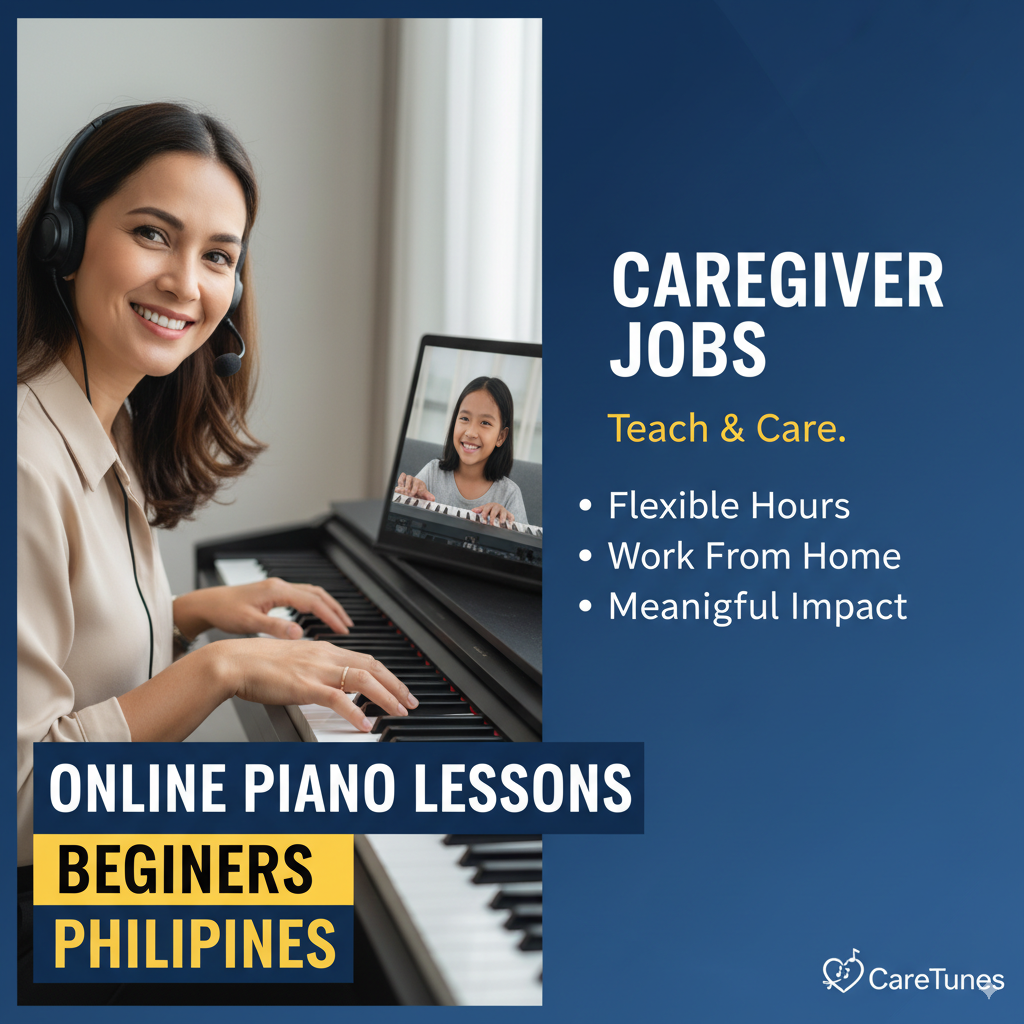Beginner’s guide to learning piano online from the Philippines
If you’re searching for online piano lessons Philippines beginners, this guide breaks down your best options (apps, subscription courses, and Filipino teachers), realistic budgets, and a simple 90-day practice plan so you start playing songs quickly.
Many learners prefer a mix of self-paced courses plus weekly live coaching — the hybrid approach reduces cost while keeping accountability high. For parents or adult learners who need Tagalog/English instruction and local scheduling, the options are growing fast.
This article covers which platforms teach technique vs. songs, what an affordable local lesson looks like, how much to budget, and a plug-and-play 12-week core plan so you (or your child) progress with structure.
Quick market research & what learners in the Philippines actually use
-
International subscription platforms that reviewers frequently recommend for beginners in 2025 include Piano Marvel, Pianote, Playground Sessions, PianoForAll, and Piano Marvel/Pianote-style offerings — these are popular because they combine progressive lessons with song libraries and interactivity. Pianist’s Compass+1
-
There is a large pool of Filipino online piano teachers and small studios offering one-on-one lessons via Zoom/Google Meet; teacher marketplaces list hundreds of Filipino tutors with rates that vary widely by experience. TeacherOn
-
University and organized music schools in the Philippines have moved portions of their private lesson offerings online and publish structured term rates (example: University-level music programs list online lesson packages and term pricing). UPD Music
-
Local blended or studio programs (small Filipino schools and private studios) also advertise weekly live lessons combined with asynchronous resources — this hybrid model is common and makes lessons flexible for working parents. Sharps ‘N Flats
-
Major music school brands (e.g., Yamaha) maintain a presence in the region with structured curricula that can be accessed or adapted for remote learners. Yamaha Philippines
What to choose (3 clear beginner pathways)
-
App / course subscription (self-study + occasional teacher check-ins)
Good if you’re on a tight budget and motivated to practice. Use a global program for structure and pair it with a monthly private coach review. -
Weekly private Filipino teacher (live one-on-one)
Best for fast progress and learners who need language support, exam preparation, or a tailored curriculum. -
Hybrid: structured course + weekly 30–45 min private lesson
Sweet spot for many parents and adults — lower cost than full private lessons but keeps accountability and feedback.
Typical prices and expectations (Philippine context)
-
Market range for live online private lessons: roughly ₱600 – ₱2,000 per hour depending on teacher experience, location, and whether the teacher is affiliated with a school or a marketplace platform. (You’ll find some listings cheaper or pricier; shop for credentials and trial lessons.) TeacherOn+1
-
University / structured term packages: some university music programs list online packages (example: 12 one-hour online lessons at academic schools can be offered as a bundle); these provide a clear syllabus and progress reporting. UPD Music
-
Subscription course costs: global apps and course platforms usually charge monthly or annual fees (many fall in the range of ~$10–$40/month for access, while teacher-led platforms may charge per-lesson). Consider total monthly cost vs. number of live hours you need. Pianist’s Compass+1
How to pick the right teacher or course (short checklist)
-
Goal match: classical technique / exam prep, pop songs, or play-by-ear improvisation?
-
Language & scheduling: Tagalog vs. English preference, time zone fit.
-
Trial lesson: always book a 30-minute sample.
-
Curriculum transparency: request a 3-month plan or syllabus.
-
Tech & instrument check: teacher should be comfortable with your keyboard/piano setup (see equipment section).
12-week beginner lesson roadmap (plug-and-play)
Weeks 1–4 (Foundations): posture, finger numbers, basic C major scale, simple 5-finger patterns, reading rhythm (quarter/eighth/rests), one simple song (e.g., “Twinkle Twinkle”).
Weeks 5–8 (Coordination): left-hand accompaniment patterns (broken chords), two-hand simple pieces, basic chord names (I–IV–V), sight-reading short pieces.
Weeks 9–12 (Expanding): more scales (G and F), arpeggios, learn a 2–3 minute pop/classical piece, basic improvisation over a simple chord progression.
Practice: 20–40 minutes daily for adults; 15–25 minutes daily for children (with focused short tasks and clear weekly goals).
Equipment & tech checklist
-
Keyboard with full-size keys and at least 61 keys (88 keys ideal); weighted keys recommended for proper technique.
-
Stable internet (≥5 Mbps upload/download for reliable video).
-
Headset with mic or good laptop microphone and a webcam angled to show both hands (teacher needs to observe posture and hand movement).
-
Recording app or phone for homework submissions.
SEO & publishing suggestions (to help this page rank)
Suggested page title (H1): Beginner online piano guide — Philippines (avoid exact target phrase in headings to follow the user’s keyword placement rule)
Suggested meta description: Step-by-step guide for beginners in the Philippines: course types, realistic prices, a 12-week roadmap, and how to choose a teacher.
Suggested URLs / slugs: /beginner-piano-philippines-online-guide
Suggested headings (H2/H3): Benefits of each learning path; How much online lessons cost; 12-week practice plan; Best equipment for beginners; FAQs
Schema: Use FAQPage schema for your Q&A section and HowTo schema for the 12-week roadmap. These can help rich results.
FAQs (short, page-ready)
Q: Can a beginner really learn online?
A: Yes—structured lessons plus consistent practice give beginners measurable progress; add periodic teacher feedback for faster correction.
Q: Should I buy a digital piano or a keyboard?
A: For serious beginners, a 76–88 key keyboard with weighted keys is recommended; upgrade to an acoustic piano later if desired.
Q: How often should kids take live lessons?
A: Once per week with short daily home practice (15–25 minutes) is a proven schedule for steady progress.
Q: What credentials should I ask a teacher for?
A: Ask about teaching experience, formal training (music degree is a plus), and whether they can provide recordings or references.
Q: Are app subscriptions enough?
A: Apps are excellent for structure and song libraries, but they lack personalized correction—pair apps with at least monthly live checks.
On-page optimization tips (for editors / publishers)
-
Use the long-tail variations in headings and subheadings (e.g., “Beginner piano courses Philippines — compare apps vs. teachers”).
-
Add local signals: city pages (Manila, Cebu, Davao), Tagalog snippets, and testimonial videos from Filipino students.
-
Offer a downloadable 12-week practice PDF to increase dwell time and backlinks.
Conclusion
Pick an approach that fits your schedule and budget: online piano lessons Philippines beginners make it possible to start quickly and affordably. If you want one-on-one feedback, choose live sessions with an experienced tutor; online piano lessons Philippines beginners plus a solid practice plan will help you reach simple repertoire within 3 months. For the most economical fast-track, combine a well-rated subscription with occasional teacher check-ins—online piano lessons Philippines beginners will give you structure, feedback, and steady progress.
Sources (key references used)
-
Reviews and roundups of top online piano platforms (Piano Marvel, Pianote, Playground Sessions). Pianist’s Compass+1
-
Teacher marketplaces and listings for Filipino online piano tutors. TeacherOn
-
University/academic music online lesson rate examples and term packages. UPD Music
-
Local blended/instructor studio offering online piano lessons (examples of hybrid programs). Sharps ‘N Flats
-
Yamaha / organized music school presence and structured curricula in the region. Yamaha Philippines


